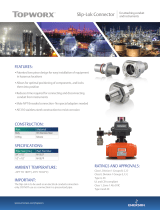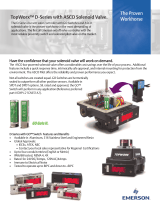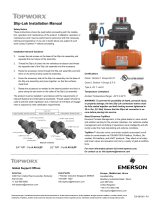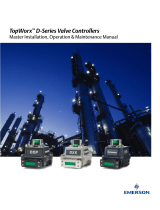
Instruction Manual
D103622X012
4310
February 2016
7
Table 1. Specifications (continued)
Power Module
(3)
Standard —Lithium, non‐rechargeable
Power Module Limits
(4)
Standard— 5 years at update rate of 16 seconds or
longer with 3 additional devices communicating
through it
Extended‐Life— 10 years at update rate of 8 seconds
or longer with 3 additional devices communicating
through it.
Shelf life— 10 years (radio off)
External Power (Optional)
12 - 28 volts DC
100 mA maximum operating current
Polarity Insensitive
Wire Size—14-20 gauge
Update Rates
For position feedback, temperature, and power
module voltage—selectable from 1 second to 1 hour;
1s, 2s, 4s, 8s, 16s, 32s, 1 to 60 minutes
Note: Sample rate for position feedback is normally
the same as the update rate. When using Report by
Exception reporting refer to Advanced Wireless
Reporting, on page 39, for additional information.
Construction Material
Housing: A03600 low copper aluminum alloy
Elastomers: nitrile, fluorosilicone
1. Normal m3/hour - Normal cubic meters per hour at 0_C and 1.01325 bar, absolute. Scfh - Standard cubic feet per hour at 60_F and 14.7 psia.
2. The pressure/temperature limits in this manual and any applicable standard or code limitation for valve should not be exceeded.
3. Due to the combustible nature of the lithium content, the power module has special installation, operation, storage, and/or shipping requirements. Observe all warnings included with the power
module before installing, operating, storing, or shipping. Contact your Emerson Process Management sales office
if additional information is needed.
4. When operating in temperatures between -10_C (14_F) and -20_C (-4_F) it is recommended that you use the extended power module, as power module life is impacted. The life expectancy of
an extended life power module used continually in the -10_C (14_F) and -20_C (-4_F) range is 3 years.
Table 2. EMC Summary Results—Immunity
Port Phenomenon Basic Standard Test Level Performance Criteria
(1)
Enclosure
Electrostatic discharge (ESD) IEC 61000‐4‐2
6 kV contact
8 kV air
B
Radiated EM field IEC 61000‐4‐3
80 to 1000 MHz @ 10 V/m with 1 kHz AM at 80%
1400 to 2000 MHz @ 10 V/m with 1 kHz AM at 80%
2000 to 2700 MHz @ 3 V/m with 1 kHz AM at 80%
A
Rated power frequency
magnetic field
IEC 61000‐4‐8 100 A/m @ 50 Hz & 60 Hz A
DC Power
(2)
Burst IEC 61000‐4‐4 2 kV (5/50 ns, 5 kHz) B
Conducted RF IEC 61000‐4‐6 10 Vrms (150 kHz to 80 MHz) A
Performance criteria: +/- 2% of effect
1. A = No degradation during testing. B = Temporary degradation during testing, but is self‐recovering.
2. Applicable to External Power option only.
Table 3. EMC Summary Results—Emissions
Port
Frequency
Range (MHz)
Basic Standard Emissions Level Given Rating
Enclosure 30 to 230 EN 55011
Group 1 Class A: 40 dB (μV/m) measured at 10 m distance
Group 1 Class B: 30 dB (μV/m) measured at 10 m distance
Class A & B
Enclosure
230 to 1000 EN 55011
Group 1 Class A: 47 dB (μV/m) measured at 10 m distance
Group 1 Class B: 37 dB (
μV/m) measured at 10 m distance
Class A & B
1000 to 3000
EN 55022
Group 1 Class B
50 dB (μV/m) measured at 3 m distance, peak limit not to exceed 70 dB (μV/m)
Class A & B
3000 to 6000
Group 1 Class B
54 dB (μV/m) measured at 3 m distance, peak limit not to exceed 74 db (μV/m)
Class A & B
NOTES:
The 4310 is considered as a Group 1 device.
Industrial, Scientific, and Medial (ISM) radio frequency (RF) equipment is rated according to its Group and Class as follows;
Group I - Equipment in which there is intentionally generated and/or used conductively coupled radio-frequency energy which is necessary for the internal functioning of the equipment itself.
Group II - Equipment in which radio-frequency energy is intentionally generated and/or used in the form of electromagnetic radiation for the treatment of material, and EDM and arc welding
equipment.
Class A - Equipment suitable for use in industrial and commercial environments
Class B - Equipment suitable for use in domestic environments

























